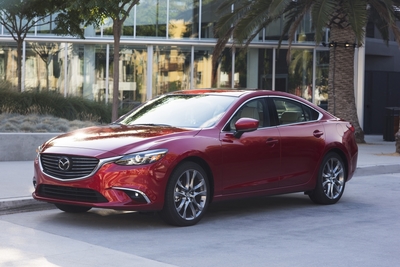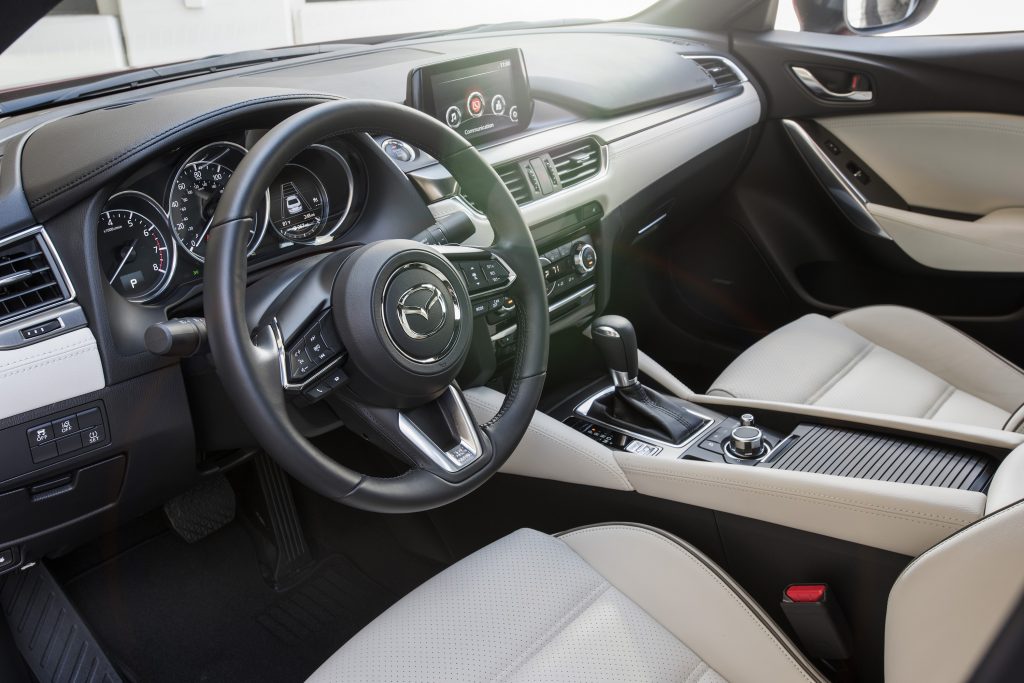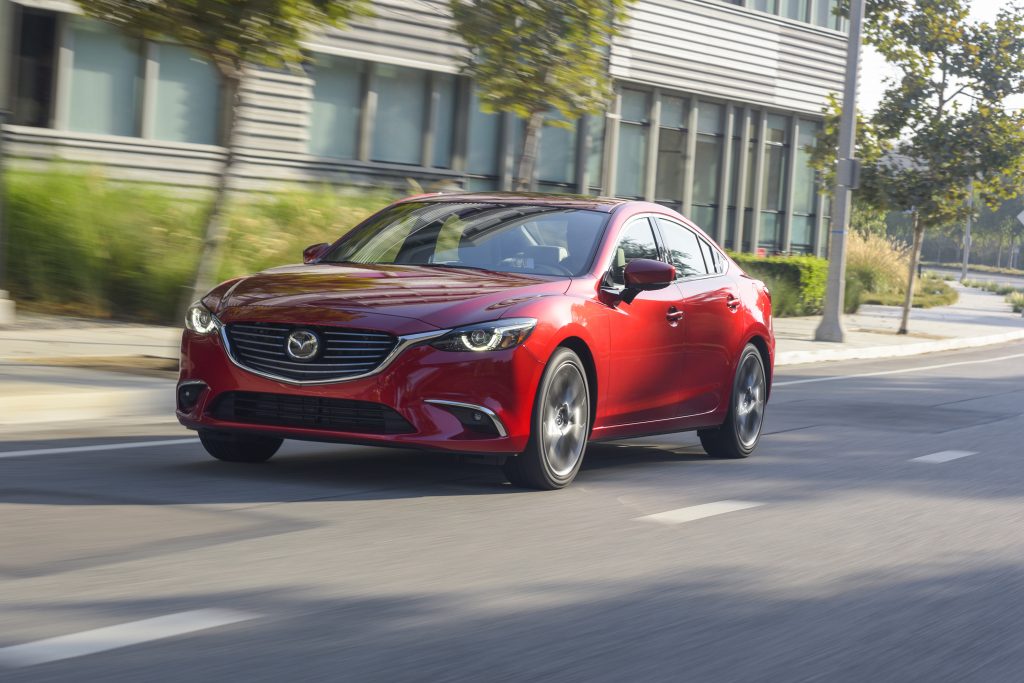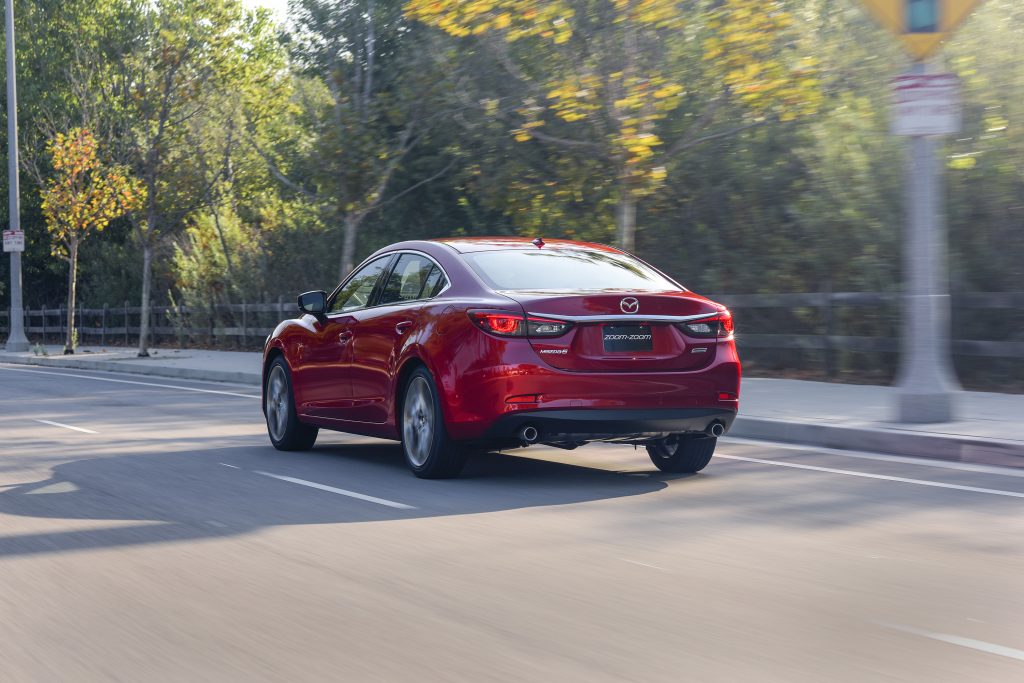2017 Mazda6 Official Release; Specs, Prices, Rationale and Options
Message from the Mazda6 Program Manager Hideki Matsuoka
Mazda’s midsize sedan continues to evolve
Our current-generation product lineup released since the launch of the Mazda CX-5 has earned customer support and high acclaim around the world for its powerful sense of vitality born of Mazda’s KODO—Soul of Motion design language and combination of driving pleasure and efficiency delivered by SKYACTIV Technology. I feel this shows our company-wide quest to deliver unique value transcending notions of class and segment is resonating with customers. Mazda is beginning to fulfill its dream of becoming an irreplaceable presence in the lives of our customers, connected to them through a strong and special bond. We strive to regularly update our products and continuously introduce the latest from Mazda to deliver greater value and refinement — because that is what customers expect from Mazda and that realizes the Mazda dream.
Mazda6 has been leading our product evolution with overwhelming appeal since debuting in 2012. It has earned high acclaim around the world, including being named the 2014 RJC Car of the Year in Japan and a Top 3 Finalist for the 2013 World Car Design of the Year. In January 2015, an exceptionally major update answered many customer requests, including the introduction of more refined exterior and interior designs and the latest safety technology and functions. This second update focuses on further advancing the high-quality touch to satisfy the desires of customers who seek the finer things in life.
To add premium value, a new interior package has been introduced featuring genuine Nappa leather and thorough refinement of every detail. The updated Mazda6 also adopts new technologies introduced with in the 2017 Mazda3. These include G-Vectoring Control (GVC), which enhances the Jinba Ittai driving experience, as well as state-of-the-art technologies. Furthermore, i-ACTIVSENSE advanced safety technologies now operate in a wider range of situations, with new functions such as pedestrian detection support added to the Advanced Smart City Brake Support (Advanced SCBS) system.
We are continuously taking on new challenges to evolve the Mazda6, aiming to strengthen our special bond with customers and develop into an irreplaceable presence in their lives. My hope is that this updated model will become a beloved partner that brightens customers’ active lifestyles.
Mazda6 Program Manager2. Design & Refinement
Supreme quality and an even more sophisticated presence
Mazda6 established its strong presence by directly expressing the KODO—Soul of Motion design language. Its first update in 2015 evolved its exterior design to become bolder and more masculine and made a leap forward in quality refinement of the interior design.
One of the focuses of this update is the further improvement of interior quality. Along with the latest design and functions being introduced, there is a new interior package that features Nappa leather seats. The subtle beauty of carefully selected genuine materials and thought-out color coordination, together with a sense of rich taste that deepens with every touch.
Exterior design
This update adds newly developed Machine Gray Metallic to the lineup of body colors.
Machine Gray Metallic accentuates the dynamic yet delicate surface structure of KODO design, treating color as an element of form. It marks the second premium finish color following Soul Red Metallic. With “the beauty of a machine’s strength and precision” as its theme, Machine Gray Metallic emphasizes KODO’s beauty by achieving an exquisite balance of high-contrast shadows and a high-density finish. To create this color, the TAKUMINURI painting technology developed for Soul Red Metallic was further advanced to increase the reflective layer’s contraction ratio during the drying process. As a result, aluminum flakes are uniformly aligned in a regular pattern within a reflective layer that is only 2.5 microns thick—about a quarter of the thickness of a conventional reflective layer. It produces a metallic texture as realistic as a professionally hand-painted finish, yet enables mass-production with a simple three-coat paint structure consisting of clear, reflective and color coats.
Seven other colors are available in the U.S.: Soul Red Metallic, Sonic Silver Metallic, Titanium Flash Mica, Blue Reflex Mica, Deep Crystal Blue, Jet Black Mica and Snowflake White Pearl Mica.
Interior design
The 2015 interior redesign greatly improved presence and quality in the Mazda6 interior. This update achieves more elegance and even better usability by refining every last detail and strengthening functionality.
Steering wheel
Mazda6 adopted a new steering wheel design first introduced in the 2016 CX-9. The smaller center pad, combined with the same outer diameter, contributes to a sharper form. Narrower satin chrome plating on the lower spoke expresses the structure of the steering wheel. Rigidity, fine texture and detailed craftsmanship are built into the design. Also, leather continues to wrap the steering wheel for a firm and smooth grip.
The three levels of steering switches on the previous horizontal spokes have been integrated into a single level. Heightened usability that matches natural finger movement and a clean design around the switches combine with satin chrome plating on the bezel surrounding the switches to accentuate the refreshingly stylish design. In Mazda6 Grand Touring models equipped with the Premium Package i, the steering wheel is laced together with the same traditional Japanese “chidori” thread pattern as what is found on the wheel of CX-9 Signature.
Also new is an available steering heater. The heaters in the grip at three o’clock and nine o’clock positions support safer and more comfortable winter driving. A new switch next to the seat heater switch controls the steering heaters, which turn off automatically about 30 minutes after being turned on.
More legible Active Driving Display and meters
This update focuses on improving the driving environment by raising the legibility of the Active Driving Display and meters to help drivers concentrate more on driving itself.
The Active Driving Display has been upgraded from the previous monochrome to full-color with higher brightness, definition and contrast. Its warnings are displayed in red and amber colors and it expresses information more smoothly, in more ways, to greatly enhance visibility and at-a-glance readability in various conditions regardless of weather and time.
The multi-information display on the right side of the triple meter cluster has been switched from the previous monochrome to a full-color TFT that enables richer expression with higher definition and contrast. This upgraded higher definition color display features more diverse functions, including a water temperature gauge that displays lower temperatures in blue and higher temperatures in red and a graphic compass. The design maintains consistency by using the same fonts as in the center display—subtly redesigned for better clarity and consistency.
Enhanced driving position memory
Besides multiple seating positions, a seat memory function can now save the angle, brightness and content setting of the Active Driving Display along with it. This function allows multiple drivers to always enjoy an optimized driving environment.
Rear Seat Heaters
New for the U.S. are rear seat heaters in the outboard rear seats in Mazda6, available in Grand Touring models equipped with the Premium Package. Seats bottoms are operated using controls in the center armrest between the seats.
An improved quality feel for the rear center armrest
On models with a rear seat heater, plating has been added to the control switch bezel installed on the rear center armrest. Also, the armrest is decorated with stitching to match the seats, highlighting the high-quality features of the model.
Quality and elegance shine in a new high-quality interior package
The Mazda6 already features a flagship-quality interior achieved through stylish design, thorough modeling and a finish refined to the last detail. This update sees a new interior package made available that further refines the high-quality feel of the model. Excellent craftsmanship heightens the premium quality and matures the value and attraction with higher, more sophisticated quality.
Higher quality materials, colors and decorations are coordinated to express the subtle elegance of the high-quality interior package. Rather than bold transformation of the design, delicate refinement of the entire interior space down to the last detail makes the Mazda6’s unique elegance stand out.
Exclusive coordination
High-quality Nappa leather seats with a plush, smooth feeling are installed in this interior package. Their surface is processed to bring out the natural leather texture, and they are accented with piping on the edges to show skilled tailoring and quality texture.
With either black- or almond-colored Nappa leather, he ceiling and pillars are black in both variations, contributing to a chic and rich interior space. The bright white interior creates a feeling of richness. The almond color textures contrast with the black ceiling and pillars. On the other hand, the black interior expresses taut, reassuring elegance through consistent black coloring throughout the entire interior highlighted by colored piping and stitches on the seats.
Warmer-toned titanium coloring with a metallic finish was chosen to complement the instrument panel, door-trim power window switch panels and shift panel. The titanium color is also used for all seat piping to harmonize the overall interior.
Additionally, the steering wheel’s center badge is accented with a plated ring. Quality finishing even extends to the details of the most inconspicuous parts, such as the leather wrapping on the non-satin-plated parts of the lower steering wheel spoke and specially designed stitches on the steering wheel’s grip. Improvements have also focused on the texture and usability of small parts touched directly by hands such as the satin chrome plating on the power seat switches and glove box knob.
Overhead console with LED downlights
LED downlights have been chosen for the overhead console. The LED’s brightness lightens the area around the floor console to improve night-time operability inside the vehicle.
3. Driving Dynamics
More intriguing and refined driving via the latest technology
Mazda pursues ideal Jinba Ittai. Toward that end, Mazda has been building cars based on a human-centered design philosophy that prioritizes people and aims to energize their minds and bodies as they drive. By consistently applying this approach, we will continuously strive to produce technologies that offer customers safety and peace of mind, and advance the quality of our vehicles in both the static and dynamic realms.
The Mazda6 delivers linear and smooth response to every driving input, delivering an experience as if the car and driver were one. The 2015 update focused on refining the pleasure of driving by enhancing smoothness and quietness based on the human-centered design philosophy.
This update takes driving quality even further by introducing G-Vectoring Control (GVC), the first of the new-generation SKYACTIV-VEHICLE DYNAMICS control technologies, and improving NVH performance for quieter, more comfortable driving. Mazda’s ever-evolving latest technology provides refined, dynamic performance, enabling high-quality driving that matches the driver’s will.
SKYACTIV VEHICLE DYNAMICS is a new-generation vehicle dynamics control technology designed to evolve Jinba Ittai
A new addition to the suite of SKYACTIV Technology, SKYACTIV-VEHICLE DYNAMICS is the name of Mazda’s new-generation vehicle dynamics control technologies. These provide integrated control over the SKYACTIV engine, transmission, chassis and body to enhance the car’s Jinba Ittai feel – a sense of connectedness between car and driver that differentiates Mazda vehicles from others.
G-Vectoring Control (GVC) – a new control technology that uses the engine to enhance chassis performance
G-Vectoring Control (GVC) makes its debut on the updated Mazda3 as the first technology in the SKYACTIV-VEHICLE DYNAMICS series. Historically, Mazda has pursued smooth transitions between G-forces when braking, turning and accelerating as it considers this an essential element of Jinba Ittai. GVC is based on the revolutionary idea of using the engine to enhance chassis performance, allied to Mazda’s human-centered development philosophy, and achieves an even smoother transition of G-forces in all driving situations.
To date, lateral and longitudinal acceleration (G) forces have been controlled separately. GVC adjusts engine torque in response to steering wheel action, delivering unified control over both of these forces and optimizing the vertical load on each wheel.
This new control technology enables smooth and efficient vehicle behavior. GVC controls engine drive torque to generate deceleration G the instant the driver begins turning the steering wheel, thereby shifting load to the front wheels. This increases front wheel tire grip, enhancing the vehicle’s responsiveness. Thereafter, when the driver maintains a constant steering angle, GVC immediately recovers engine drive torque, transferring load to the rear wheels to enhance vehicle stability. This series of load transfers draws out much more grip from the front and rear tires, enhancing vehicle responsiveness and stability better aligned with the driver’s intentions.
The effect of GVC is very natural and does not impose any feeling of discomfort on the driver or passengers. This is because the human-centric development concept employed produces a reaction rate and amount of control that is aligned with human sensibilities. The reaction time from the moment the driver turns the steering wheel is quick enough to be imperceptible, and the extremely subtle amount of deceleration force added by GVC normally amounts to 0.01 G or less. One of the features of GVC is a natural driving feel enhanced by quicker and more precise control than is possible for a human driver to achieve.
GVC is only possible thanks to SKYACTIV engines, which enable precise control of drive torque, and the SKYACTIV-CHASSIS, which facilitates ideal vehicle behavior. As a highly versatile technology, GVC can be deployed in any SKYACTIV model, irrespective of its specific drivetrain or category. In addition, since GVC is a software control system, there is no weight increase due to additional hardware components.
GVC demonstrates its effect consistently over a wide range of driving situations, regardless of the driver’s level of skill. Whether traveling at everyday low speeds, driving in a straight line at high speeds, traversing winding roads or making emergency evasive maneuvers, this control technology offers a number of benefits. Because GVC optimizes the vertical load on the tires to match the driving conditions and keep the vehicle following the driver’s intended path, it greatly reduces the amount and frequency of necessary steering corrections, many of which are unconscious. This enables the driver to more easily maintain his or her intended line, creating a stronger feeling of unity between driver and car, instilling greater confidence in driving, and reducing accumulated fatigue on long drives.
Also, by smoothing the transitions between G-forces experienced by the driver and passengers and thereby suppressing swaying of their heads and bodies, GVC provides all occupants with a more comfortable and enjoyable drive.
Lastly, GVC delivers better handling and greater stability on slippery surfaces, such as in the rain or when driving on snowy roads. It enhances the feeling that the tires are firmly gripping the road and gives vehicle occupants a greater sense of security.
NVH performance
Road and wind noise reduction
In the 2015 update, the Mazda6 took a leap forward in terms of quietness at highway speeds and on rough roads by applying various measures throughout the vehicle. For further improvements in quietness, efforts were exerted in the 2017 update to enhance sound insulation and greatly enhance the clarity of conversations during driving.
The measures introduced include thorough suppression of noise entry through gaps by molding weather strip terminals around doors and improving the sealing performance between rear door trims and inner panels as well as between seaming welts and body flanges in the front and rear doors. Moreover, the use of significantly thicker front door glass and the wider application of sound-absorbing materials in the headliner improve sound insulation and absorption performance.
Soundproof glass with an acoustic membrane between glass layers was chosen for the top-trim Grand Touring model’s front door glass, similar to what can be found in CX-9 Grand Touring and Signature models.
Continuous evolution of new-generation direct injection engine SKYACTIV-G
This update further improves the driving quality of SKYACTIV-DRIVE equipped vehicles. Mazda identified the factors that control linear vehicle response and refined torque rise characteristics after pressing on the accelerator pedal to make response more linear. Highly responsive SKYACTIV-G combines with the refined performance of SKYACTIV-DRIVE six-speed automatic transmission or SKYACTIV-MT six-speed manual.
4. Safety
Safety performance continues to advance for all our customers
The 2015 update introduced i-ACTIVSENSE* on the Mazda6 to enhance recognition support for the driver with new functions. Its already outstanding safety performance is combined with various leading safety technologies to ensure an enjoyable and secure driving experience.
The 2017 Mazda6 seeks to further improve safety performance by adding new functions to i-ACTIVSENSE. A newly added camera on Smart City Brake Support (SCBS) makes it easier to detect pedestrians during forward movement and widens the range of speeds over which the system operates. A newly developed Traffic Sign Recognition (TSR) system also automatically identifies traffic signs and notifies the driver. In addition, Smart Brake Support (SBS) has been advanced to operate over a wider speed range.
The Mazda6 advances continuously by adopting the latest functions to provide superior safety performance in all driving conditions.
*i-ACTIVSENSE is an umbrella term covering a series of advanced safety technologies that employ detection devices such as milliwave radar units and cameras to support the driver in recognizing hazards, avoiding collisions, and minimizing damage in the event an accident does occur.
Active safety: i-ACTIVSENSE
Traffic Sign Recognition System (TSR)
The Forward Sensing Camera can detect speed signs during driving and display the identified speed limit in the Active Driving Display. It warns the driver by blinking graphics on the display three times when the speed exceeds the limit. Audible alert by sounding a buzzer is also available. This encourages safer driving and helps the driver always feel confident by preventing speed signs from being overlooked. With TSR, Mazda6 can display speed limits on roads without the presence of speed signs because its maps in the navigation system contain speed limit data. Also, North American-specification models can identify No Entry and Stop signs.
Smart Brake Support (SBS)
SBS detects vehicles and obstacles on the road ahead while driving and helps avoid collisions and mitigate damage by sounding an audible alert and applying the brakes in two stages. The 2017 model receives an update with an extended operation speed range from the previous approximate 9–90 mph to 9–99 mph by combining the existing millimeter-wave radar with a newly developed Forward Sensing Camera.
Note: The system’s ability to prevent a collision is limited by road conditions and other environmental factors.
Safety technologies carried over from the previous model
|
Active safety |
North America |
| High-Beam Control system (HBC) |
○ |
| Adaptive LED Headlights (ALH) |
– |
| Adaptive Front-lighting System (AFS) |
○ |
| Smart City Brake Support [Reverse] (SCBS R) |
– |
| Advanced Blind Spot Monitoring (ABSM) with Rear Cross Traffic Alert (RCTA) |
○*1 |
| Lane-keep Assist System (LAS) and Lane Departure Warning System (LDWS) |
○*2 |
| Driver Attention Alert (DAA) |
– |
| Mazda Radar Cruise Control (MRCC) |
○ |
| Dynamic Stability Control (DSC) and Traction Control System (TCS) |
○ |
| 4-Wheel Anti-lock Braking System (4W-ABS) + Electronic Brake-force Distribution (EBD) + Brake Assist |
○ |
| Emergency Signal System (ESS) |
○ |
| Hill Launch Assist (HLA) |
○ |
|
Passive safety |
North America |
| High-strength SKYACTIV-BODY |
○ |
| SRS airbag system |
○ |
| Front seatbelts with pretensioner and load limiter |
○ |
| Front seat that mitigates shock to the neck |
○ |
| Rear seat that prevents luggage from entering the cabin |
○ |
| Impact-absorbing steering shaft |
○ |
| Rear seat ISOFIX-compliant child-seat anchors and top tethering anchorage (left and right seats) |
○ |
*1: Changes from Blind Spot Monitoring (BSM)
*2: Lane-keep Assist System (LAS) is available for the first time with this update.
 |
IRVINE, Calif. (August 9, 2016) – Mazda North American Operations today introduced the 2017 Mazda6, gaining further premium refinements and continuing to redefine the notion that one need not compromise driving pleasure for practicality and efficiency.
Long regarded as one of the best-handling, most-engaging vehicles in its segment, Mazda6 again raises the bar with Mazda’s first application of the all-new G-Vectoring Control (GVC) in North America. GVC is the first in a series of new SKYACTIV-VEHICLE DYNAMICS technologies that provide integrated control of the engine, transmission, chassis and body to enhance the car’s Jinba Ittai—“horse and rider as one”—feel.
GVC benefits drivers with more precise control of their vehicles, which its engineers have designed to help reduce the need for steering corrections, leading to greater confidence and control both in day-to-day and spirited driving.
But engineers didn’t stop there. Their desire to seek constantly higher goals led them to bestow Mazda6 with greatly enhanced sound insulation.
Using improved door seals, tighter tolerance between panels and sound insulation materials added to the underbody, rear console, headliner and doors, the aim for Mazda6 was to outclass common midsize-segment cars with its attractive design and establish a unique “Mazda Premium” positioning. Further improvements include thicker front glass to block wind noise, and Grand Touring models receive laminated front side windows.
The 2017 Mazda6 also receives available Nappa leather seating surfaces with contrast-color piping in Grand Touring models equipped with the Premium Package. Other Premium Package contents include a black headliner and heated steering wheel with traditional Japanese chidori stitching similar to what can be found in CX-9 Signature models, heated rear outboard seats, i-ELOOP regenerative braking technology and a bright metallic finish to switches and trim throughout the interior.
Other improvements include a newly available full-color Active Driving Display with font made uniform to what is found in the rest of Mazda6’s displays for both clarity and conformity as well as a 4.6-inch, full-color TFT meter display in Grand Touring models. Traffic Sign Recognition, Lane-Keep Assist and Advanced Blind Spot Monitoring have also made their way into the 2017 Mazda6. Entry Mazda6 Sport models now come equipped with MAZDA CONNECTTM when equipped with a SKYACTIV-MT six-speed manual transmission as well as the available SKYACTIV-DRIVE six-speed automatic.
These enhancements join a long list of upgrades made to the previous year’s Mazda6, which included a completely redesigned interior, a new front fascia when equipped with full LED headlights in certain models, an LED-backlit “signature wing” grille, seven-inch MAZDA CONNECTTM display with Commander control knob, white LED interior lighting, electronic parking brake and Sport Mode switch in models equipped with automatic transmissions.
In the U.S., Mazda6 continues to be one of the few midsize sedans offered with an available manual transmission for discerning enthusiasts. All U.S. models are powered by a 184-horsepower, 2.5-liter SKYACTIV-G engine.
The 2017 Mazda6 arrives in dealers in September, with pricing to be announced closer to its on-sale date.






